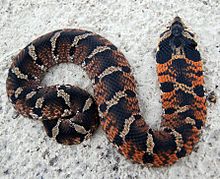Eastern hognose snake
| Eastern hognose snake | |
|---|---|

| |
| eastern hog-nosed snake (southern Georgia morph) | |
| Scientific classification | |
| Domain: | Eukaryota |
| Kingdom: | Animalia |
| Phylum: | Chordata |
| Class: | Reptilia |
| Order: | Squamata |
| Suborder: | Serpentes |
| Family: | Colubridae |
| Genus: | Heterodon |
| Species: | H. platirhinos
|
| Binomial name | |
| Heterodon platirhinos | |
| Synonyms | |
| |
Heterodon platirhinos, also known as the Eastern hognose snake, is a species of mildly venomous colubrid snake. It lives throughout North America.
Description[change | change source]
The average length for an adult eastern hognose snake is 71 cm (28 in) in length. The most amazing feature is the upturned nose. It is used for digging in sandy soils. It can be red, green, orange, brown or gray to black depending on where it comes from. The belly tends to be a solid gray, yellow, or cream-colored.[3][4]
Distribution and Habitat[change | change source]
It is found from southern New Hampshire south to the southern tip of Florida and into the central United States. Eastern hognose snakes are also found as far west as Texas, Oklahoma, Kansas, Nebraska, and into the southern tip of South Dakota. In total, they are found in about thirty states in the United States and are also found in southern Ontario.[5]
Eastern hognose snakes are mostly found in places with dry, sandy, or mixed sandy soils. They are usually found in grassy fields, fields that contain crops, and along woodland edges. Sometimes they can be found near small bodies of water. Eastern hognose snakes are also sometimes found in buildings such as greenhouses and barns.[5]
Diet[change | change source]
The Eastern hognose snake eats mainly frogs, lizards, salamanders, insects, other invertebrates, and small rodents. It is only mildly venomous. That means that, much like garter snakes, there's only enough toxins in their saliva to paralyze small animals.
Predators[change | change source]
The predators of the Eastern hognose snake are raccoons, Virginia opossums, red foxes, hawks, common king snakes, cottonmouths, tarantulas.[5]
Behaviour[change | change source]
Eastern hognose snakes are diurnal animals. They will swim to cross between habitats and to find food or mates. Eastern hognose snakes are mostly active from early April until October or November depending on the temperature. Eastern hognose snakes usually begin hibernation anywhere from early September into November. If the temperatures drop to 19 degrees Celsius, they will begin their hibernation. Eastern hognose snakes hibernate by themselves in either burrows made by themselves or abandoned mammal burrows. Eastern hognose snakes tend to burrow at night into sandy soil.[5]
Reproduction[change | change source]
Eastern hognose snakes mate in April and May. They lay 8 - 40 eggs in June or early July. They do not take care of the eggs or young. The eggs hatch after about 60 days, from late July to September. The hatchlings are 16.5–21 cm (6.5–8.3 in) long.[6]
Defense[change | change source]
When threatened, the hognose will play dead. It sometimes even lets its tongue hang from its mouth.
Venom[change | change source]
It is often thought to be nonvenomous because it is not harmful to humans but it does have venom. Bitten humans who are allergic to the saliva have been known to experience swelling, but no human deaths have been recorded.
Conservation status[change | change source]
Eastern hognose snakes are listed as least concern on the IUCN red list. In the future, they may be threatened because of habitat destruction and decrease in the number of toad in their native areas. Eastern hognose snakes are sometimes mistaken for pygmy rattlesnakes and are often killed because of this.[5]
Economic importance[change | change source]
Eastern hognose snakes eats lots of small mammals, insects, and amphibians and therefore limit their populations. They have the strongest role in limiting toad populations. Eastern hognose snakes have been reported to be mildly venomous to humans.[5]
References[change | change source]
- ↑ Hammerson, G.A. (2007). "Heterodon platirhinos". IUCN Red List of Threatened Species. 2007: e.T63820A12718733. doi:10.2305/IUCN.UK.2007.RLTS.T63820A12718733.en. Retrieved 13 October 2020.
- ↑ Heterodon platirhinos at the TIGR Reptile Database. Accessed 14 September 2007.
- ↑ Smith, Hobart M. (Hobart Muir), 1912-2013. (1982). Reptiles of North America : a guide to field identification. Brodie, Edmund D., Dennis, David M., Barlowe, Sy. New York: Golden Press. ISBN 0-307-13666-3. OCLC 8785374.
{{cite book}}: CS1 maint: multiple names: authors list (link) CS1 maint: numeric names: authors list (link) - ↑ Blair, W. Frank; Conant, Roger (1959). "A Field Guide to Reptiles and Amphibians of Eastern North America". AIBS Bulletin. 9 (1): 44. doi:10.2307/1292749. ISSN 0096-7645. JSTOR 1292749.
- ↑ 5.0 5.1 5.2 5.3 5.4 5.5 Jessee, Renee. "Heterodon platirhinos (Eastern Hognose Snake)". Animal Diversity Web. Retrieved 2020-09-18.
- ↑ Schmidt, Karl P; Davis, D Dwight (1941). Field Book of Snakes of the United States and Canada. New York: G P Putnam's. doi:10.5962/bhl.title.110918.

